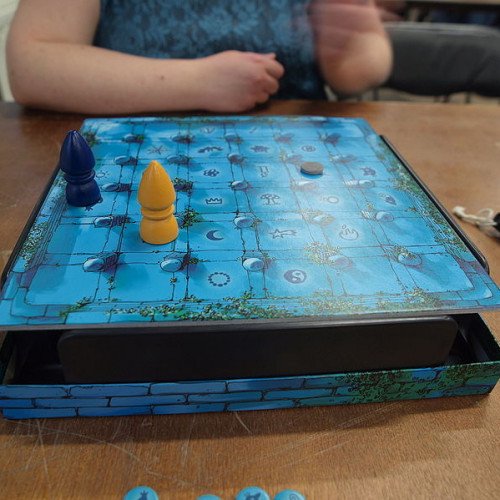"THE MAGIC LABYRINTH" vs "MAHJONG"

THE MAGIC LABYRINTH
The Magic Labyrinth is a 2009 board game designed by Dirk Baumann, for two to four players. The Magic Labyrinth is a labyrinth game with the objective of finding treasures hidden in the labyrinth. The twist in the game is that the labyrinth's walls are invisible. The game has a wizard setting and is played over a 6x6 rectangular grid representing a labyrinth. The labyrinth's walls are actually placed under the board, invisible to the players. The player's pieces consist of a wizard piece on top of the board, and a metal sphere underneath the board, connected to the wizard piece by a magnet. The pieces start out from the four corners of the board. At the start of the game, a treasure is randomly selected, and the players have to get to the square representing the treasure. On his/her turn, a player throws a die deciding how many spaces his/her piece can move. If the player's piece hits a wall, the metal sphere underneath the board falls off, audible to the player. When this happens, the player forfeits his/her turn, having to move his/her piece back to the starting corner. The idea of the game is that the players can't actually see the walls, only learning of them when they hit them. To be able to proceed, players must learn to memorise the locations of the walls. If a player successfully reaches a treasure, he/she claims it as his/her own, and another treasure is randomly dealt. The first player to claim five treasures wins.
Statistics for this Xoptio

MAHJONG
Mahjong or mah-jongg (English pronunciation: /mɑːˈdʒɒŋ/ mah-JONG, Mandarin Chinese: ) is a tile-based game that was developed during the Qing dynasty in China and has spread throughout the world since the early 20th century. It is commonly played by four players (with some three-player variations found in parts of China, Japan, South Korea and Southeast Asia). The game and its regional variants are widely played throughout Eastern and South Eastern Asia and have also become popular in Western countries. The game has also been adapted into a widespread online entertainment. Similar to the Western card game rummy, Mahjong is a game of skill, strategy, and luck. The game is played with a set of 144 tiles based on Chinese characters and symbols, although some regional variations may omit some tiles or add unique ones. In most variations, each player begins by receiving 13 tiles. In turn players draw and discard tiles until they complete a legal hand using the 14th drawn tile to form four melds (or sets) and a pair (eye). A player can also win with a small class of special hands. There are fairly standard rules about how a piece is drawn, how a piece is robbed from another player, the use of suits (numbered tiles) and Honors (winds and dragons), the kinds of melds allowed, how to deal the tiles and the order of play. Despite these similarities, there are many regional variations to the rules including rather different scoring systems, criteria for legal winning hands, and even private table rules which distinguish some variations as notably different styles of mahjong.